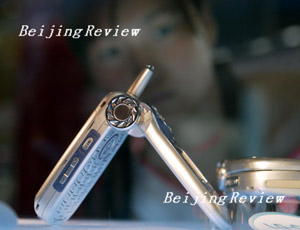|

Since the late 1990s, Chinese mobile players have caught up rapidly with cutting-edge mobile services, while the Chinese marketplace has become an R&D hub for multinational companies and a test laboratory for large-scale ad campaigns by global marketers. As China prepares to enter the third-generation (3G) industry, it is faced with both great challenges and great opportunities.
Scale and mobile services
In late summer 2002, Coca-Cola ran a short message service (SMS) ad campaign, featuring an interactive contest. Contestants could win a year's supply of Coke or Siemens cellphones. More than 4 million messages were exchanged and 50,000 Coke ad jingles were downloaded in the 35 days when the "Coke Cool Summer" promotion ran across China.
"We are thrilled with the results, which frankly exceeded expectations," said Sumanta Dutta, Coca-Cola China's Brand Director. "Consumers can look forward to Coke adding more fizz on this platform, which is now clearly a key part of our consumers' lifestyle."
"In early 2005, we helped Coca-Cola--probably our most active mobile marketing client-to launch their interactive marketing initiative iCoke, which has now been rolled out globally," said John Gregg of McCann Erickson Guangming in Shanghai. "The promotion was extremely successful. At its peak iCoke was receiving 2 million unique visitors per day."
"Scale is enormous in China," said David Turchetti, CEO of 21 Communications, which works closely with the country's two major mobile service providers--China Mobile and China Netcom. "We've used SMS as a means of prompting consumers to a point of sale or to some desired action, as when Kentucky Fried Chicken was launching Lao Beijing, a kind of Beijing Chicken Wrap. With Kentucky Fried Chicken, Dell, Estee Lauder and others, these campaigns have been the brand's first mobile experience worldwide."
With mobile programming, on-demand video has heralded the coming of mobile TV. Chinese players have followed suit. In March 2005, Appointment--a 25-minute TV drama to be shown exclusively on mobile phones--began shooting in China.
With the Supergirl show, the hottest American Idol-style contest on Chinese television in 2005, the interplay of SMS and broadcasting became a national pastime. Some 9 million votes were dialed in for the final voting. It is reported that SMS revenue flows will account for half of last year's total profits for Hunan Satellite TV, Supergirl's producer.
All leading mobile markets are rushing toward mobile TV and China is no exception. During May Day holidays in 2004, China Unicom launched a service to provide TV programs for mobile phone subscribers, followed by China Mobile.
Mobile subscriber growth is driven by the strong replacement market in urban areas and by users in rural China gaining access to mobile communications. Last year, the total global mobile subscriber base hit 1.7 billion. By 2010, some expect it to reach 3 billion. Of these new subscriptions, nearly one fourth will be in China.
From China's standpoint, the problem is that even hyper growth provides no guarantee of superior competitive advantage.
Chinese 3G standard
In the absence of Chinese patents, incumbent mobile leaders--taking advantage of their current mobile technologies--tend to dominate profits in China. If, however, Chinese companies could secure patents with their 3G standard, they could secure a foothold for continuous development.
That, in a nutshell, is the logic of China's accelerating 3G efforts.
"China reveals 3G agenda," reported Chinese news agencies right before last New Year's Eve. Reportedly, China will speed up policies on 3G mobile communications in 2006. The ambitious objective is to form a new 3G industry chain, said Wang Xudong, Minister of Information Industry.
The story goes back to mid-December 2000, when the TD-SCDMA Forum was established by eight companies, including China Mobile, China Telecom, China Unicom, Datang, Huawei, Motorola, Nortel Networks and Siemens, to promote the new tech standard worldwide.
Chinese government policies are hardly an exception in the mobile phone history. During the 1980s, the mobile industry was dominated by the AMPS technology of the United States. During the 1990s, it was led by the European GSM technology, which the European Commission made mandatory in EU nations. Since the early 2000s, the industry has transitioned to the 3G era, which has witnessed specialization in mobile technology (Northern Europe), services (Japan), chips and software (the United States), and broadband (South Korea).
The slow adoption of 3G worldwide has provided China a new window of opportunity-but an opportunity with a painful record in Western Europe, where failures of operators and vendors, as well as mistaken policies of governments (overpriced license auctions), contributed to the industry bust.
After the extraordinary success of i-mode in Japan, NTT DoCoMo launched the world's first commercial 3G service in 2001. By late 2005, there were only 50 million 3G/UMTS customers worldwide (almost half of them in Japan)--a fraction of the worldwide base of 2.1 billion subscribers.
Great risks, great opportunities
The original 3G/UMTS objective was a single standard, which would allow rapid globalization in the early 2000s. Over time, this goal became blurry because all major players--large EU nations and small Nordic countries, the United States, Japan and South Korea--sought to boost the fortunes of their producers.
In 1999--after years of negotiations, threats of trade wars, backstabbing and realignments-the then--dominant mobile players decided to develop a single flexible standard. In practice, this has led to several international 3G standards.
| 